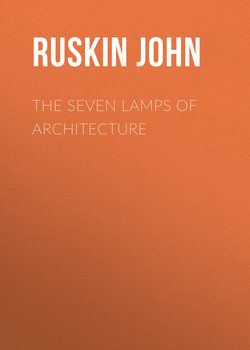The Seven Lamps of Architecture

Реклама. ООО «ЛитРес», ИНН: 7719571260.
Оглавление
Ruskin John. The Seven Lamps of Architecture
PREFACE
INTRODUCTORY
CHAPTER I. THE LAMP OF SACRIFICE
CHAPTER II. THE LAMP OF TRUTH
CHAPTER III. THE LAMP OF POWER
CHAPTER IV. THE LAMP OF BEAUTY
CHAPTER V. THE LAMP OF LIFE
CHAPTER VI. THE LAMP OF MEMORY
CHAPTER VII. THE LAMP OF OBEDIENCE
NOTES
Note I
Note II
Note III
Note IV
Note V
Note VI
Note VII
Note VIII
Note IX
Note X
Note XI
Note XII
Note XIII
Note XIV
Note XV
Note XVI
Note XVII
Отрывок из книги
The memoranda which form the basis of the following Essay have been thrown together during the preparation of one of the sections of the third volume of "Modern Painters."1 I once thought of giving them a more expanded form; but their utility, such as it may be, would probably be diminished by farther delay in their publication, more than it would be increased by greater care in their arrangement. Obtained in every case by personal observation, there may be among them some details valuable even to the experienced architect; but with respect to the opinions founded upon them I must be prepared to bear the charge of impertinence which can hardly but attach to the writer who assumes a dogmatical tone in speaking of an art he has never practised. There are, however, cases in which men feel too keenly to be silent, and perhaps too strongly to be wrong; I have been forced into this impertinence; and have suffered too much from the destruction or neglect of the architecture I best loved, and from the erection of that which I cannot love, to reason cautiously respecting the modesty of my opposition to the principles which have induced the scorn of the one, or directed the design of the other. And I have been the less careful to modify the confidence of my statements of principles, because in the midst of the opposition and uncertainty of our architectural systems, it seems to me that there is something grateful in any positive opinion, though in many points wrong, as even weeds are useful that grow on a bank of sand.
Every apology is, however, due to the reader, for the hasty and imperfect execution of the plates. Having much more serious work in hand, and desiring merely to render them illustrative of my meaning, I have sometimes very completely failed even of that humble aim; and the text, being generally written before the illustration was completed, sometimes naïvely describes as sublime or beautiful, features which the plate represents by a blot. I shall be grateful if the reader will in such cases refer the expressions of praise to the Architecture, and not to the illustration.
.....
XIV. Finally, work may be wasted by being too good for its material, or too fine to bear exposure; and this, generally a characteristic of late, especially of renaissance, work, is perhaps the worst fault of all. I do not know anything more painful or pitiful than the kind of ivory carving with which the Certosa of Pavia, and part of the Colleone sepulchral chapel at Bergamo, and other such buildings, are incrusted, of which it is not possible so much as to think without exhaustion; and a heavy sense of the misery it would be, to be forced to look at it at all. And this is not from the quantity of it, nor because it is bad work—much of it is inventive and able; but because it looks as if it were only fit to be put in inlaid cabinets and velveted caskets, and as if it could not bear one drifting shower or gnawing frost. We are afraid for it, anxious about it, and tormented by it; and we feel that a massy shaft and a bold shadow would be worth it all. Nevertheless, even in cases like these, much depends on the accomplishment of the great ends of decoration. If the ornament does its duty—if it is ornament, and its points of shade and light tell in the general effect, we shall not be offended by finding that the sculptor in his fulness of fancy has chosen to give much more than these mere points of light, and has composed them of groups of figures. But if the ornament does not answer its purpose, if it have no distant, no truly decorative power; if generally seen it be a mere incrustation and meaningless roughness, we shall only be chagrined by finding when we look close, that the incrustation has cost years of labor and has millions of figures and histories in it and would be the better of being seen through a Stanhope lens. Hence the greatness of the northern Gothic as contrasted with the latest Italian. It reaches nearly the same extreme of detail; but it never loses sight of its architectural purpose, never fails in its decorative power; not a leaflet in it but speaks, and speaks far off, too; and so long as this be the case, there is no limit to the luxuriance in which such work may legitimately and nobly be bestowed.
PLATE I.—(Page 33—Vol. V)
.....